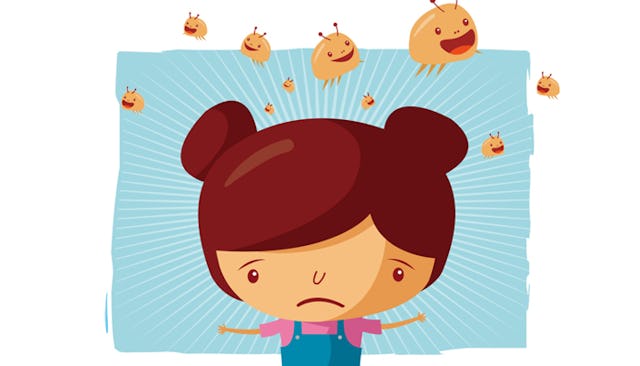Get Rid of Lice without Losing Your Dignity

Here’s how it usually works: right around the time you’re feeling like you’ve got this whole mom thing down, you get a call from your kid’s school, informing you that he has lice. If you’re really lucky, this will happen in the middle of an important board meeting. And you’ll be on speakerphone.
What is it about the word lice that sends a shiver up the spine and a pit down into the stomach? The fact is, head lice is pretty much a rite of passage in childhood. It’s found (and spread) most commonly in children ages 5 to 12 because of the way they play: lots of touching, tagging, roughhousing, sharing dress up clothes or whispering silly secrets. That makes schools, childcare centers, locker rooms, camps and slumber parties prime spots for lice outbreaks.
So, lice. Now what?
Don’t panic or beat yourself up. This has nothing to do with hygiene. In fact, lice prefer clean, healthy heads. Remember, your child takes his emotional cues from you, so the most important thing you can do is act like this isn’t a big deal, because, guess what? It really isn’t a big deal!
First, you’ll need to verify for yourself that you find lice. Sometimes, when there’s been an outbreak, there are misdiagnoses. Use a magnifying glass and a flashlight (the one on your smartphone is perfect) to inspect your child’s scalp. Look for irritation from itching around the ears, crown, and back of the neck. Since lice run from light, you’ll have better luck looking for nits (lice eggs), which are a teardrop shape, about the size of a grain of sugar. They have a pearly shine and always lie on only one side of the hair shaft. It’s easy to mistake dandruff or dried hair product for nits; the key difference is that nits do not come off easily. If you think you see a nit, run your finger over it. A nit will feel hard like a shell and will not move, almost as if it’s tightly glued to the hair shaft. Live lice are light brown and about the size of a sesame seed.
OK, yes, definitely lice. Now what?
The most effective treatment is the old-fashioned method of combing hair with a special lice comb and conditioner, and painstakingly removing nits and lice manually. (Fun fact: this is where the term “nit-picking” comes from! Not your mother-in-law as previously thought.) This is the least harmful method. There are also businesses that specialize in lice removal; they can be pricey, but usually offer a guarantee.
Home remedy treatments (smothering hair with olive oil, mayonnaise or Vaseline) as well as over-the-counter and prescription drugs in the form of shampoos, cream, and lotions (such as Rid or Nix) are other options to consider, though results can vary. Depending on your child’s age and skin sensitivity, consult your pediatrician or family doctor for advice.
Once the lice are killed, you will have to patiently and diligently remove nits with a special lice comb (extra-fine teeth and generally made of metal). Your local drugstore should carry them.
Keep in mind that lice can live on a head for up to 30 days (though it would be rare to go unnoticed that long) and up to 48 hours in the environment. Wash all bedding, towels, clothing and beloved stuffed animals in a washing machine and treat them with a high-heat spin in the dryer. Soak all combs and brushes in hot water (at least 130° F) for 5-10 minutes. Vacuum carpets and play areas. Clothing and items that are not washable can be placed in a sealed plastic bag and stored for two weeks. This should help contain the lice to just one person in the family.
Phew! No more lice. Now what?
Some simple measures can actually prevent your child from getting lice again:
- Don’t wash your child’s hair every day. Buildup of natural oils on the hair shaft makes it harder for lice to attach.
- Choose tea tree oil-based shampoos and sprays. These are natural and safe for children of all ages. Use shampoo every other day, and use spray regularly on hair, pillowcases, hoods and hats.
- Teach your kids to avoid sharing hats, scarves, hair accessories, brushes or combs with friends, even when playing dress up.
- Regularly clean items your child’s head frequently touches, like pillows, sleeping bags, car seats, and headphones.
Once you’ve de-loused and taken preventative steps, give your child a high five. You beat lice together! See? Not a big deal!
And now you can pour yourself a glass of wine and order a pair of shoes on Zappos. Seriously, go ahead. You’ve earned it!
Related post: The 5 Stages of Lice
This article was originally published on